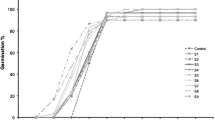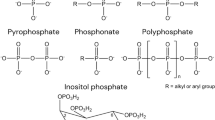Abstract
Effects of shading on the growth of Equisetum arvense during the growing season were studied in terms of the dynamics of non-structural carbohydrates (starch, sucrose, glucose). Tubers of 0.04 g dry mass were planted in pots. Plants were cultivated under different radiation conditions (100%, 3%, 100%→3%, and 100%→3%→100%). The carbohydrate concentration in belowground parts responded sharply to the irradiance conditions. Under 3% relative photon flux density (PFD), they could not grow beyond the initial mass and decayed. Dry mass per length of rhizomes was highly correlated with the starch concentration, which was correlated with the mass of current tubers. The rhizomes of low starch concentration did not form current tubers. The carbohydrate concentration of rhizomes increased when the plants were transferred from 3% relative PFD to 100% irradiance conditions. After ca. 2 months of improved PFD, they had the same content of non-structural carbohydrates as the 100% PFD plants.






Similar content being viewed by others
References
Asahina Y (1927) Gametophytes of Equisetum arvense (in Japanese). J Jpn Bot 6(10):300–301
Borg PJ (1971) Ecology of Equisetum palustre in Finland, with special reference to its role as a noxious weed. Ann Bot Fen 8:93–141
Cloutier D, Watson AK (1985) Growth and reproduction of field horsetail (Equisetum arvense ). Weed Sci 33:358–365
Gray VM (2000) A comparison of two approaches for modeling cassava (Manihot esculenta Crantz.) crop growth. Ann Bot 85:77–90
Grime JP, Hodgson JC, Hunt R (1988) Comparative plant ecology: A functional approach to common British species. Unwin Hyman, London, pp 254–259
Gulmon SL, Mooney HA (1986) Costs of defense and their effects on plant productivity. In: Givnish TH (ed) On the economy of plant form and function. Cambridge University Press, Cambridge, pp 681–698
Hartmann HT, Kester DE (1966) Plant propagation. Principles and practice, 2nd edn. Prentice-Hall, London, pp 503–536
Hauke RL (1966) A systematic study of Equisetum arvense. Nova Hedwigia 13:81–109
Hauke RL (1985) The transition from vegetative to reproductive growth of shoot apices of holoheterophyadic species of Equisetum : phenology, morphology and anatomy. Can J Bot 63:2430–2438
Hill JD, Silander Jr JA (2001) Distribution and dynamics of two ferns: Dennstaedtia punctilobula (Dennstaedtiaceae) and Thelypteris noveboracensis (Thelypteridaceae) in a northeast mixed hardwoods-hemlock forest. Am J Bot 88(5):894–902
Hori Y, Oshima Y (1986) Life history and population dynamics of the Japanese yam, Dioscorea japonica. 1, Effect of initial plant size and light intensity on the growth. Bot Mag (Tokyo) 99:407-418
Hutchings MJ (1999) Clony plants as cooperative systems: benefits in heterogeneous environment. Plant Species Biol 14:1–10
Ito M, Watanabe Y, Ueki K (1987) Seasonal growth and enrichment of belowground parts of Equisetum arvense (in Japanese). Weed Res Jpn 32(Suppl):127–128
Ito M, Watanabe Y, Ueki K (1988) Patterns of expansion in the belowground parts of Equisetum arvense (in Japanese). Weed Res Jpn 33(Suppl):193–194
Iwasa Y, Kubo T (1997) Optimal size of storage for recovery after unpredictable disturbances. Evol Ecol 11:41–65
Marrs RH, Pakeman RJ, Lowday JE (1993) Control of bracken and the restoration of heathland. V. Effects of bracken control treatments on the rhizome and its relationship with frond performance. J Appl Ecol 30:107–118
Marshall G (1986) Growth and development of field horsetail (Equisetum arvense L.). Weed Sci 34:271–275
Meyer K, Hellwig FH (1997) Annual cycle of starch content in rhizomes of forest geophytes Anemene nemorosa and Aegopodium podagraria. Flora 192:335–339
Moorby J (1980) Transport systems in plants (translated into Japanese by Hori H). Hakuyuusha, Tokyo, pp 103–109
Mutoh N, Yoshida KH, Yokoi Y, Kimura M, Hogetsu K (1968) Studies on the production processes and net production of Miscanthus sacchariflorus community. Jpn J Bot 20(1):67–92
Nihei N, Sasaki T, Yamazaki S (1967) Ecology and chemical control of field horsetail (in Japanese). Weed Res Jpn 6:94–100
Ohwi J (1957) Flora of Japan. Pteridophyta (in Japanese). Sibundo, Tokyo, p 4
Pakeman RJ, Marrs RH (1996) Modeling the effects of climate change on the growth of bracken (Pteridium aquilinum ) in Britain. J Appl Ecol 33:561–575
Ruiters C, McKenzie B (1994) Seasonal allocation and efficiency patterns of biomass and resources in the perennial geophyte Sparaxis grandiflora subspecies fimbriata (Iridaceae) in lowland coastal fynbos, South Africa. Ann Bot 74:633–646
Sakamaki Y, Ino Y (2002) Influence of shade timing on an Equisetum arvense L. population. Ecol Res 17:673–686
Sergeeva LI, de Bruijin SM, Koot-Gronsveld EAM, Navratil O, Wreugdenhil D (2000) Tuber morphology and starch accumulation are independent phenomena: evidence from ipt–transgenic potato lines. Physiol Plant 108:435–443
Slade AJ, Hutchings MJ (1987) An analysis of the costs and benefits of physiological integration between ramets in the clonal perennial herb Glechoma hederacea. Oecologia 73:425–431
Suzuki J, Hutchings MJ (1997) Interactions between shoots in clonal plants and the effects of stored resources on the structure of shoot populations. In: de Kroon H, van Groendad J (eds) The ecology and evolution of clonal plants. Backhuys, Leiden, pp 311–329
Suzuki J, Stuefer JF (1999) On the ecological and evolutionary significance of storage in clonal plants. Plant Species Biol 14:11–17
Williams ED (1979) Studies on the depth distribution and on the germination and growth of Equisetum arvense L. (field horsetail) from tubers. Weed Res 19:25–32
Williams GW, Forey A (1975) Seasonal variations in the carbohydrate content of bracken. Bot J Linn Soc 73:87–93
Acknowledgements
We thank Dr. Yasuyuki Oshima, Japan Wildlife Research Center, for his support, valuable suggestions and helpful advice. We are also grateful to the members of the Ecological Laboratory of Waseda University for their kind assistance and advice.
Author information
Authors and Affiliations
Corresponding author
Rights and permissions
About this article
Cite this article
Sakamaki, Y., Ino, Y. Response of non-structural carbohydrate content of belowground parts in Equisetum arvense according to the irradiance change during a growing season. J Plant Res 117, 385–391 (2004). https://doi.org/10.1007/s10265-004-0171-5
Received:
Accepted:
Published:
Issue Date:
DOI: https://doi.org/10.1007/s10265-004-0171-5




